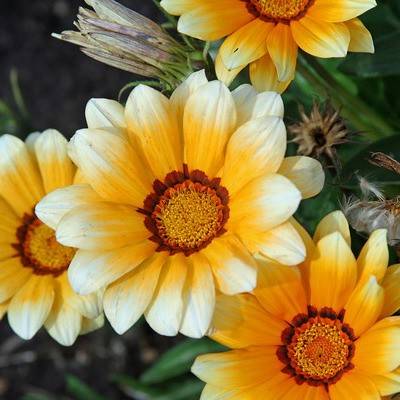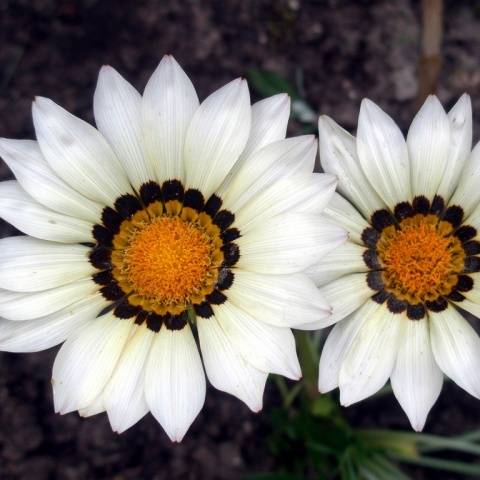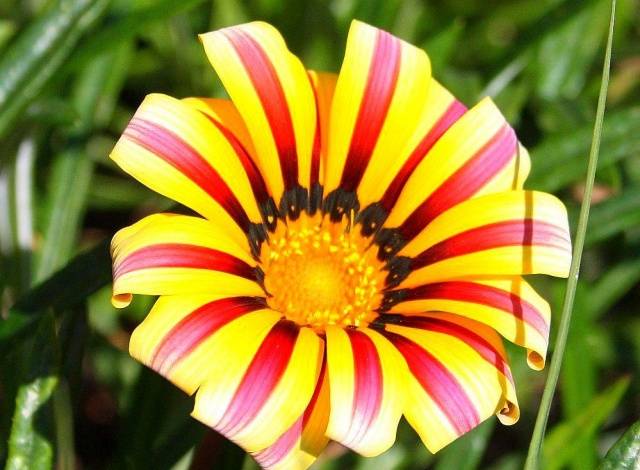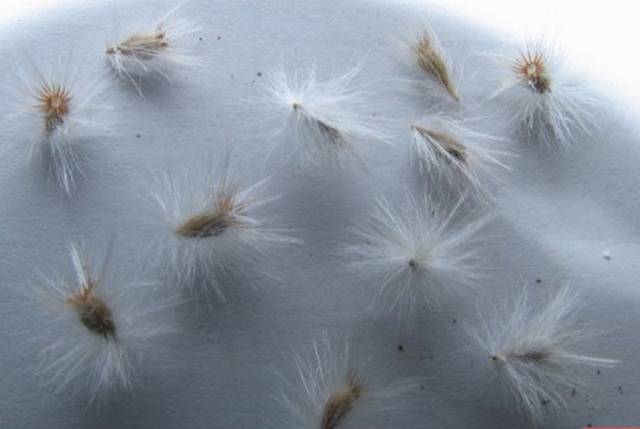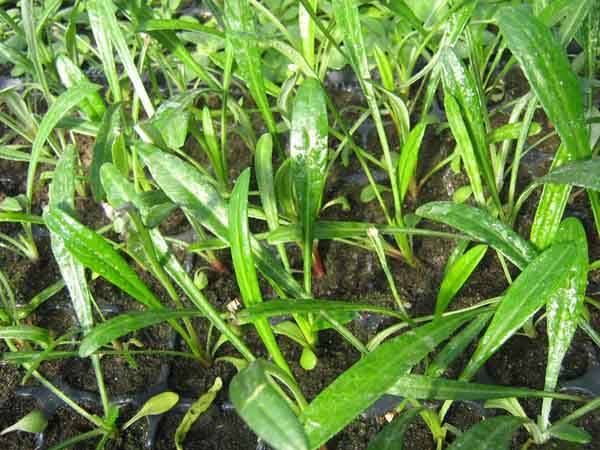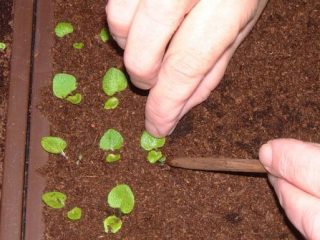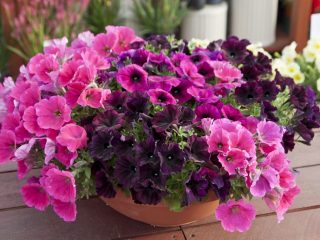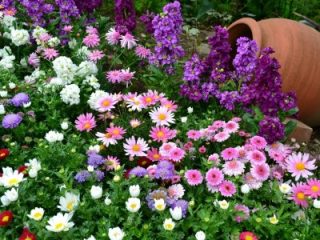Content
Gatsania... This short but very beautiful flower has several names. Gazania was named after the Greek scientist Theodoro Gaza. The flower received the names “African Chamomile” and “Midday Sun” in its homeland, Africa. Indeed, Gatsania opens its petals with the first rays of the sun and closes them with the onset of evening.
Description of the plant
Gazania belongs to the Asteraceae family. This heat-loving flower was brought to Europe in the 17th century. Considering that Gazania was brought from a continent where the sun is always hot and bright, then the conditions for this plant need to be created appropriately.
Gatsaniya fully justifies its second name. Its flowers, like little suns, will decorate any flower bed and give gardeners a great mood. Often, African flowers are planted for decorative purposes or to create compositions in landscape design.
The height of Gazania does not exceed 30 cm. These parameters depend on the variety and on compliance with the conditions for growing Gazania from seeds: when to plant, what kind of soil the flower likes, how often to water.Therefore, it is very important to approach this process with due responsibility in order to subsequently enjoy the beauty of these extraordinary flowers to the fullest.
Variety of varieties
The inflorescences of Gazania flowers are small, up to 15 cm in diameter. Their size and color depend on the variety. But for the most part, the color range of shades is represented by warm tones.
At the moment, several types of African chamomile are known:
- harsh (or also called shiny);
- long-armed;
- peacock;
- single-flowered;
- snow white;
- pinnate.
However, thanks to the work of breeders, new, hybridized varieties of Gazania have been developed, having a rich palette of bright flower baskets. Yellow, orange, red, pink – the magnificence and richness of colors is simply amazing! In total, there are more than 40 varieties of Gatsania flowers in nature.
Despite the fact that African chamomile is considered a garden flower, you can grow Gatsania from seeds at home. Bright, unique flowers will decorate your windowsill and lift your spirits during the winter frosts.
The author of the video will tell you how to grow Gatsania on a windowsill:
You can see some of the most beautiful varieties of Gatsania flowers in the photo:
Daybreak Orange Cream
Kiss Flame F1
Sunshine
Frosty Kiss Red
Frosty Kiss White Flame
New Day Pink Shades
Kiss White
Rassvet F1 brindle pink
Rassvet F1 brindle red
Gatsania Peacock
A brief description of each type of Gazania flower is presented in the form of a table
Name of the type of flowers of Gatsania | Plant height, cm | Diameter of flowers, cm | Color range of this type | Characteristics |
Long-rifle | 15 — 25 | 7 — 8 | bright yellow | The petals are brown at the base. |
Brilliant | up to 30 | 4 — 6 | dark red, sunny yellow, bright orange | The bases of the petals are black or red |
Peacock | up to 30 | more than 8-10 | deep pink, yellow, orange | The flowers have narrow petals. The base of the reed-shaped petals is predominantly black. |
White | until 25-30 | more than 10 | reed petals are dazzling white, tubular petals are yellow-brown | They can bloom in insufficient sunlight. Flowers close their heads only at dusk. |
Single-flowered | up to 15 | 5-7 | pale yellow | The most compact flowers. Can be classified as curb. |
The first flowers bloom on the bushes in mid-June, and Gazania blooms until late autumn.
Growing conditions
The Gatsania flower, as a representative of the African flora, is a light-loving and heat-loving plant. It is unpretentious in care and calmly tolerates such phenomena as drying out of the soil, lack of watering or short-term, minor frosts. Therefore, when growing Gatsania from seeds at home, there are no particular difficulties.
Having a core structure of the root system, the plant is able to absorb life-giving moisture from lower layers of soil. And the villi on the underside of the leaf help preserve it during drought.
In South Africa and Mozambique, the Gazania flower is a perennial flower. But Russian winter frosts do not allow Gazania to be grown all year round, and therefore the plant is considered an annual.
But flower growers have found a way out and replant Gatsania in deep boxes in the fall, store it in a warm room at a temperature not lower than +5˚С +10˚С, and in the spring they plant it again in the flowerbed.
You can avoid unnecessary hassle and grow the Gatsania flower immediately in large pots or flowerpots, and with the onset of autumn simply move the containers into the house. In spring, without much effort, you will be able to admire the unique colorful flowers again.
The author of the video will tell you how you can preserve Gatsania until spring:
Reproduction methods
Despite the fact that Gazania is a perennial, in Russia it is mainly grown as an annual. You can grow Gatsania from seeds, or you can propagate it by cuttings.
Seed collection
Seeds for growing Gatsania flowers at home can be purchased in online stores, or you can prepare them yourself. But not in all regions the seed pods have time to ripen due to early autumn.
Flower seeds ripen 1.5-2 months after the flower baskets have bloomed. The peculiarity of Gatsania seeds is that they are very similar to dandelion seeds, and as soon as they ripen, they can be carried away by the first gusts of wind.
Therefore, as soon as the Gazanias fade, put thin cotton or gauze bags over the wilted flowers. This way, when the seeds are ripe, you can collect them.
Cuttings
Propagating Gazania flowers using rosette cuttings will help you preserve the varietal characteristics of the plant.Unlike growing Gatsania from seeds at home, in this case you will save the precious time the plant needs to form and grow the root system.
You can combine the propagation process with autumn work in the garden. You need to dig up roots for long-term storage in late September - early October.
You need to dig up Gatsania with a pitchfork so as not to damage the root system. Inspect the plant and roots carefully. Only healthy, powerful shoots are suitable for vegetative propagation. There should be a slight thickening at the base of the socket.
Carefully remove the bottom two leaves and separate the healthy rosettes with clean scissors or a knife. Treat all sections with Kornevin solution to stimulate active root growth. Plant the separated cuttings of Gatsania flowers in pots with a diameter of at least 10-12 cm. Water the flowers.
Place containers with Gazania in a warm, bright place. But keep in mind that direct sunlight should not fall on the plantings. It will take at least 1-1.5 months for Gatsania to take root. So be patient. Plants need to be watered as the soil dries out.
Gazania can be planted in a flowerbed in the spring, in mid-to-late May.
The author of the video will tell you how to grow Gatsania without sowing, as well as how to properly propagate a flower from cuttings:
Agrotechnics of cultivation
Growing Gatsania from seeds at home is not as difficult as it might seem at first glance. The main thing is to follow planting dates and recommendations for caring for plants.
Landing dates
Considering that Gatsania gains color 2.5-3.5 months after the first green shoots appear, you need to prepare for planting seeds in advance.Therefore, when determining the time when it is time to plant Gatsania seedlings, you need to focus on the climatic conditions of the region.
It is not advisable to grow Gazania without seedlings, since the plant simply does not have time to grow and delight you with a variety of bright colors. Moreover, young shoots are not resistant to low temperatures. Grown in open ground, during spring return frosts, Gazania may not bloom, or even freeze out completely.
At the same time, you should not plant Gatsania seeds for seedlings too early or later than the recommended dates.
Early planting will require additional hassle in the form of daily additional illumination with phytolamps or fluorescent lamps. If the seeds are planted too late, Gatsania may not bloom at all.
For residents of the southern regions, the optimal time for sowing Gatsania seedlings occurs in mid-late February. But in the central zone of Russia and Siberia, you can sow seeds only in early to mid-March.
Preparing for landing
Before growing Gatsania seedlings from seeds, you need to prepare suitable containers and soil. Seedlings can be grown either in shallow containers followed by picking, or in bulk containers. It is important to remember that Gatsania has a taproot. This means that the planting containers must be spacious so that the root does not bend, but grows straight.
The soil for growing Gatsania from seeds at home should be loose and fertile, with acidity levels in the range of 5.5-6 Ph. You can also use ready-made soil for this purpose, balanced in the composition of minerals and nutrients.
Before planting, do not forget to place a drainage layer on the bottom of the planting containers to drain excess water.
Sowing technology
Gatsania flower seeds do not need pre-treatment before planting. But if you wish, you can soak them in water or a growth stimulant for several hours.
The algorithm for planting Gatsania seedlings will look like this:
- pour soil into prepared containers 2/3 of the total volume;
- carefully arrange the Gatsania seeds in a checkerboard pattern at a distance of 2-2.5 cm from each other;
- pour soil on top no more than 1 cm high;
- water the plantings, cover with transparent polyethylene, and place in partial shade.
And now, before the first green shoots appear, open the plantings 2-3 times a week for aeration and promptly remove excess moisture that accumulates as condensation on the polyethylene.
Gatsania should be watered no more than 2-3 times a week. Do not over-moisten the soil, otherwise the seeds may rot. But you shouldn’t let it dry out either, otherwise it will be difficult for the weak shoots of Gatsania to break through the dry crust of the earth. Keep the soil moist.
When growing Gatsania from seeds, create a suitable microclimate for the flowers. The optimal air temperature in the room with seedlings should not be lower than +18˚С +20˚С. Do not create drafts and avoid direct sunlight on the boxes with future flowers.
Gatsania flower seeds germinate in 1.5-2 weeks. Further care of the seedlings consists of regular watering.
The author of the video will share with you the secrets of growing Gatsania from seeds:
Picking
You can start picking Gatsania in the phase of appearance of 3-4 leaves.It is best to plant seedlings in separate containers to avoid damaging the root system of each seedling during subsequent replanting.
When planting Gatsania seedlings, adhere to the following recommendations:
- Fill prepared containers (plastic, peat glasses, cut bottles, flower pots, boxes, flowerpots) 2/3 with soil. Flowerpots or boxes need to be filled 3/4 full with soil.
- Make small holes 10-15 cm deep, water well with warm water.
- Using a spoon or spatula, carefully remove the sprout along with a lump of earth, being careful not to damage the roots, and transfer it to the prepared planting holes.
- Level the hole and compact the soil a little around the plant.
Place the peaked flowers of Gatsania in partial shade. It is undesirable for it to be exposed to direct sunlight for 1.5-2 weeks. After this period, you can move the plants to a brighter place.
Before transplanting Gatsania into open ground, you will have to follow standard procedures for caring for seedlings: watering and carefully loosening the top layer of soil. Gatsaniya won’t ask for more from you.
The author of the video will show you how to properly pick Gatsania seedlings:
Transplantation into open ground
Gatsania can be transplanted into open ground no earlier than mid-May. Adult flowers are not afraid of temperature drops to –5˚С –7˚С, but young bushes will invariably die under these conditions, as they do not have sufficient resistance to spring frosts. Therefore, there is no need to rush with the transfer.
Hardening
Tender seedlings of Gatsania flowers must be hardened off before transplanting into a flower bed or flower garden.Hardening begins 2-3 weeks before transplantation with daily ventilation of the room in which the boxes with seedlings are located.
After a few days, the seedlings should be taken outside for a short time, provided that the weather is good. The first hardening procedure takes no more than 20-30 minutes. Gradually, the “walk” time needs to be increased.
Only after the plants have become stronger can they be transplanted to a permanent location.
Choosing a suitable place
Gatsaniya is a flower of the sun. Therefore, a sunny area with loose and fertile soil will be a suitable place for growing African chamomile.
It is not advisable to plant Gazania in a windy place.
The area intended for flowers must be carefully dug up and, if necessary, fertilized.
In the area prepared for Gatsania flowers, make holes 15-20 cm deep at a distance of 20-25 cm from each other. Transplantation of seedlings is carried out in several stages:
- Water the seedlings at least a day or two before transplanting. Do not over-moisten the soil. and it’s also not worth starting replanting if the soil is dry. In both cases, you risk causing irreparable harm to the plants.
25 - You need to remove the seedlings from the container together with the soil so as not to damage the roots.
- Place Gatsania in the planting hole, gradually filling the voids with soil.
- Firm the soil at the base of the flower and water well.
As you can see, no special skills are required when growing Gatsania flowers. And when in a few weeks these bright, unusual and beautiful flowers bloom in your flower garden, you will receive true pleasure.
Further care
Gatsania is unpretentious, and further flower care will consist of following the usual measures familiar to every gardener:
- weeding;
- loosening;
- feeding;
- watering.
If there is a threat of frost, cover the plantings with lutrasil or plastic wrap. You need to feed Gatsania flowers no more than 1-2 times a month.
For abundant flowering, it is recommended to remove faded inflorescences once every 2 weeks.
If desired, you can mulch the flower garden to avoid unnecessary hassle with weeding and frequent watering. Flowerbeds need to be watered as the top layer of soil dries.
What problems may arise
When growing Gatsania, problems may arise, the causes and methods of combating which are indicated in the table.
Problem encountered | Probable Cause | Possibility of elimination |
Lack of shoots | 1. Failure to comply with the rules of agricultural technology when planting and growing 2. Seed shelf life has expired | Follow the recommendations for growing and caring for flowers. |
Weak sprouts | 1. Failure to comply with recommendations regarding the indoor microclimate 2. Poor lighting | 1. Create favorable conditions for seedling growth 2. If there is a lack of sunlight, provide the plantings with additional illumination for 2 hours in the morning and evening |
Diseases (grey mold and other fungal diseases) | 1. Waterlogging of the soil 2. Insufficient aeration 3.Thickened plantings | 1. Regulate watering 2. Weed the flower garden in a timely manner and remove wilted buds 3. Loosen the soil regularly 4. Remove affected areas of plants 5. Treat flower beds with antifungal drugs |
Pests: aphids, snails, spider mites | 1. Overwatering 2. Lack of lighting 3.Thickened plantings
| 1. Stop watering for a while 2.Provide free access of fresh air to plants. If the plantings are thickened, it is worth thinning out the flowerbed. 3. Collect snails by hand 4. Treat your flower garden with pest control products |
Lack of buds or poor flowering | 1. Violation of the rules of care 2. Late transplantation into open ground 3. Excessive waterlogging of the soil 4. Flowers grow in the shade | Follow the recommendations for growing and caring for flowers. |
In general, Gatsania flowers are highly resistant to common diseases and most pests. As can be seen from the data presented in the table, most problems arise when the recommendations of experienced gardeners are not followed.
To avoid difficulties and fully enjoy the beauty and grace of flowers, follow the rules for caring and growing Gatsania.
Conclusion
As you have probably seen, growing Gatsania from seeds at home is not such a difficult process. And when Gazania blooms, a truly enchanting sight awaits you. At first, the first flowers appear on the flowerbed, but as they develop, more and more inflorescences bloom on the bushes, coloring the flower garden with bright, unique colors.


